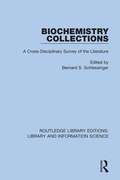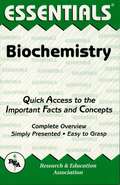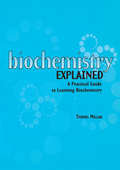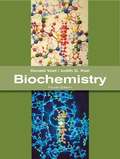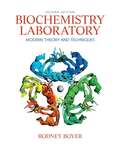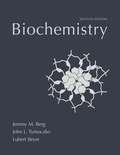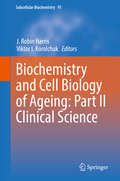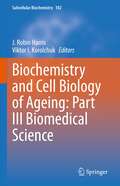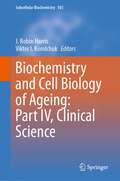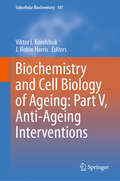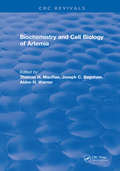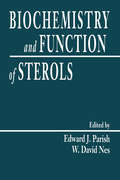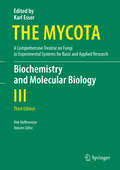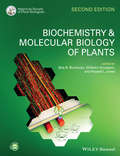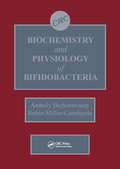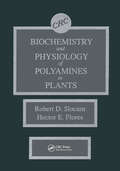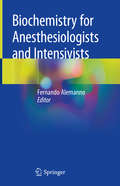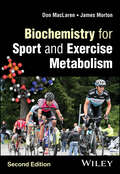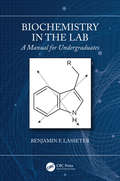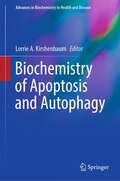- Table View
- List View
Biochemistry Collections: A Cross-Disciplinary Survey of the Literature (Routledge Library Editions: Library and Information Science #10)
by Bernard S. SchlessingerThis book, first published in 1982, offers an examination of the special nature of biochemistry collections. It focuses on the production, control, and use of the literature – diverse in nature, and analysed here by specialist contributors.
Biochemistry Essentials
by Jay TemplinREA's Essentials provide quick and easy access to critical information in a variety of different fields, ranging from the most basic to the most advanced. As its name implies, these concise, comprehensive study guides summarize the essentials of the field covered. Essentials are helpful when preparing for exams, doing homework and will remain a lasting reference source for students, teachers, and professionals. Biochemistry includes biological structure, chemistry of proteins, enzymes, bioenergetics, carbohydrates, lipids, metabolism of amino acids and proteins, nucleic acids, and extra cellular and intracellular fluids.
Biochemistry Explained: A Practical Guide to Learning Biochemistry
by Thomas MillarBiochemistry Explained employs an innovative approach which has proven highly successful in the author's own classes. The author establishes a thorough understanding of the foundations of and common linkages between molecular structures and reactions, so that eventual interpretation of complex biochemical pathways and reactions is easy. All of the major molecular structures and biochemical pathways are explained, and, for the most part, these center on mammalian biochemistry. The text is supported by biochemical nomenclature and questions to bear in mind while reading. Higher learning sections are also provided for advanced students. Written in an informal, conversational style, this textbook will serve as an invaluable resource for any student who is struggling with the standard texts and for postgraduate students who need to refresh their knowledge.
Biochemistry For Dummies
by John T. Moore Richard H. LangleyGrasp biochemistry basics, apply the science, and ace your examsAre you baffled by biochemistry? If so here's the good news ? you don't have to stay that way! Biochemistry For Dummies shows you how to get a handle on biochemistry, apply the science, raise your grades, and prepare yourself to ace any standardized test.This friendly, unintimidating guide presents an overview of the material covered in a typical college-level biochemistry course and makes the subject easy to understand and accessible to everyone. From cell ultrastructure and carbohydrates to amino acids, proteins, and supramolecular structure, you'll identify biochemical structures and reactions, and send your grades soaring. Newest biology, biochemistry, chemistry, and scientific discoveriesUpdated examples and explanationsIncorporates the most current teaching techniquesFrom water biochemistry to protein synthesis, Biochemistry For Dummies gives you the vital information, clear explanations, and important insights you need to increase your understanding and improve your performance on any biochemistry test.
Biochemistry For Dummies
by John T. Moore Richard H. LangleyIt’s alive! It’s alive! (Thanks to biochemistry, that is.) Biochemistry is the science of the chemical processes that allow for…well…life. If it moves, breathes, eats, or sleeps, biochemistry can probably explain how. So, it stands to reason that the fundamentals of biochemistry can get a little complicated. In Biochemistry For Dummies, you’ll explore the carbons, proteins, and cellular systems that make up the biochemical processes that create and sustain life of all kinds. Perfect for students majoring in biology, chemistry, pre-med, health-services, and other science-related fields, this book tracks a typical college-level biochemistry class. It simplifies and clarifies the subject with easy-to-follow diagrams and real-world examples. You’ll also get: Explorations of cell biology, carbohydrates, proteins, lipids, and other fundamental building blocks of life Discussions of the basic structures common to all living organisms Treatments of the microscopic details of life that make us all tick If you’re looking for a hand with some of the trickier parts of biochemistry—or you just need an accessible overview of the subject—check out Biochemistry For Dummies today!
Biochemistry Fourth Edition
by Donald Voet Judith G. VoetThe "Gold Standard" in Biochemistry text books, Biochemistry 4e, is a modern classic that has been thoroughly revised. Don and Judy Voet explain biochemical concepts while offering a unified presentation of life and its variation through evolution. Incorporates both classical and current research to illustrate the historical source of much of our biochemical knowledge.
Biochemistry Laboratory: Modern Theory and Techniques
by Rodney BoyerYour biochemistry lab course is an essential component in training for a career in biochemistry, molecular biology, chemistry, and related molecular life sciences such as cell biology, neurosciences, and genetics. <p><p>Biochemistry Laboratory: Modern Theory and Techniques covers the theories, techniques, and methodologies practiced in the biochemistry teaching and research lab. Instead of specific experiments, it focuses on detailed descriptions of modern techniques in experimental biochemistry and discusses the theory behind such techniques in detail. An extensive range of techniques discussed includes Internet databases, chromatography, spectroscopy, and recombinant DNA techniques such as molecular cloning and PCR. <p><p>The Second Edition introduces cutting-edge topics such as membrane-based chromatography, adds new exercises and problems throughout, and offers a completely updated Companion Website.
Biochemistry Seventh Edition
by John L. Tymoczko Jeremy M. Berg Lubert StryerSince its first edition in 1975, this extraordinary textbook has helped shape the way biochemistry is taught, offering exceptionally clear writing, innovative graphics, coverage of the latest research techniques and advances, and a signature emphasis on physiological and medical relevance. Those defining features are at the heart of the new Seventh Edition of Biochemistry, which again communicates fundamental concepts and the latest breakthroughs in a way that makes the information engaging and understandable for students approaching the subject for the first time.
Biochemistry and Cell Biology of Ageing: Part I Biomedical Science (Subcellular Biochemistry #90)
by J. Robin Harris Viktor I. KorolchukThis new volume in the Subcellular Biochemistry series will focus on the biochemistry and cellular biology of aging processes in human cells. The chapters will be written by experts in their respective fields and will focus on a number of the current key areas of research in subcellular aging research. Main topics for discussion are mitochondrial aging, protein homeostasis and aging and the genetic processes that are involved in aging. There will also be chapters that are dedicated to the study of the roles of a variety of vitamins and minerals on aging and a number of other external factors (microbiological, ROS, inflammation, nutrition). This book will provide the reader with a state of the art overview of the subcellular aging field. This book will be published in cooperation with a second volume that will discuss the translation of the cell biology of aging to a more clinical setting and it is hoped that the combination of these two volumes will bring a deeper understanding of the links between the cell and the body during aging.
Biochemistry and Cell Biology of Ageing: Part II Clinical Science (Subcellular Biochemistry #91)
by J. Robin Harris Viktor I. KorolchukThis volume of the subcellular Biochemistry series will attempt to bridge the gap between the subcellular events that are related to aging as they were described in the first volume of this set of two books and the reality of aging as this is seen in clinical practice. All chapters will start from the biochemistry or cell biology, where the data is available and work up towards the understanding that we have of aging in the various areas that are related to the subject. Key focus points for this volume are nutrition, external factors and genetics on aging. There will also be chapters that will focus on various organs or tissues in which aging has been well studied, like the eyes, the muscles, the immune system and the bones. The aim of the book project and the book project that is published in concert with this volume is to bring the subcellular and clinical areas into closer contact.
Biochemistry and Cell Biology of Ageing: Part III Biomedical Science (Subcellular Biochemistry #102)
by J. Robin Harris Viktor I. KorolchukThis book provides a state-of-the-art overview of key areas of subcellular aging research in human cells. The reader is introduced to the historical development and progress in biomedical aging research and learns, for example, about the role of microRNAs, circRNAs, mitochondria and extracellular vesicles in cellular senescence. The reader will also learn more about how gap junctions, the nuclear pore complex and the proteasome are affecting the ageing processes. In addition, novel therapeutic opportunities through modulation of cellular senescence are discussed. The book follows on from Parts I and II of Biochemistry and Cell Biology of Ageing (Volumes 90 and 91 of the Subcellular Biochemistry book series) by covering interesting and significant biomedical ageing topics not included in the earlier volumes. Comprehensive and cutting-edge, this book is a valuable resource for experienced researchers and early career scientist alike, who are interested in learning more about the fascinating and challenging question of why and how our cells age.
Biochemistry and Cell Biology of Ageing: Part IV, Clinical Science (Subcellular Biochemistry #103)
by J. Robin Harris Viktor I. KorolchukThis book provides an up-to-date overview of key areas of ageing research and bridges the gap between the subcellular events and the reality of ageing as seen in clinical practice.To this end, the reader learns about the historical development and progression of clinical ageing research. All chapters address the biochemistry or cell biology of various ageing events (to the extent that the data are available) and work their way to the clinical understanding we have of ageing. The focus of this volume is on how dietary restriction, virus infection and chronic inflammation affect the ageing process. Additionally, this book discusses how phosphate metabolism and metabolic dysfunction contribute to ageing events and how various organs and tissues (e.g. tendons, ears, heart muscle, and the endocrine system) age. This book follows on from Parts I, II and III of Biochemistry and Cell Biology of Ageing within the Subcellular Biochemistry book series and aims to bring the subcellular and clinical areas into closer contact by including interesting and significant biomedical ageing topics that were not included in the earlier volumes. Comprehensive and cutting-edge, this book is a valuable resource for experienced researchers and early career scientist alike, who are interested in learning more about the fascinating and challenging question of why and how our cells age.
Biochemistry and Cell Biology of Ageing: Part V, Anti-Ageing Interventions (Subcellular Biochemistry #107)
by J. Robin Harris Viktor I. KorolchukThis book provides an up-to-date overview of key areas of ageing research with a special focus on anti-ageing intervention strategies, which are currently very much at the forefront of ageing studies.The volume discusses how dietary restriction, supplements or exercise affect the ageing process. Other intervention strategies reviewed are: chaperone activators, telomerase activation, hormetics, senolytics, NAD boosting, geroprotectors, stem cell therapies, resveratrol and melatonin, to just name a few. This book follows on from Parts I-IV of Biochemistry and Cell Biology of Ageing within the Subcellular Biochemistry book series and highlights anti-ageing intervention strategies that were not included in the earlier volumes. Comprehensive and cutting-edge, this book is a valuable resource for experienced researchers and early career scientists alike, who are interested in learning more about the fascinating and challenging question of why and how our cells age.
Biochemistry and Cell Biology of Artemia
by Thomas H. MacRaeThe unusual life history of the brine shrimp, Artemia, and the relative ease with which it can be experimentally manipulated have long made his crustacean a favorite system for biological studies. Over the years, descriptive morphological work has given way to a rigorous analysis of biochemical and cellular aspects of the organism. The underlying theme of the work is often been developmental in nature.This book brings together a wide spectrum of topics under study in the shrimp. Analyses of gene structure and protein synthesis are combined with descriptions of protein interactions characteristic of functional cells.
Biochemistry and Function of Sterols
by Edward J. Parish W. David NesLeading international scientists bring current and developing topics in sterol research together in Biochemistry and Function of Sterols. The authors are experts in each major area of sterol research-medicine, biochemistry, chemistry, and agriculture. Each chapter features the current state of research as well as new and developing research topics. Throughout the volume the focus is on the major and expanding areas of sterol biochemistry and function of sterols in all classes or organisms. The broad scope of this work embraces many disciplines and will be of interest to a variety of researchers, students, and lay people. Professors will find Biochemistry and Function of Sterols an excellent choice as a textbook for courses on steroid, lipid, or plant biochemistry.
Biochemistry and Molecular Biology (The Mycota #III)
by Dirk HoffmeisterThis new edition provides a comprehensive look at themolecular genetics and biochemical basis of fungal biology, covering importantmodel organisms such as Aspergilli while also integrating advances made with zygomycetes and basidiomycetes. This book groups a total of 15 chapters authored by expert scholars in theirrespective fields into four sections. Five chapters cover various aspects ofgene expression regulation. These range from regulation in organismalinteractions between parasitic fungi and their host plant, heavy metal stressand global control of natural product genes to conidiation and regulationthrough RNA interference. Two chapters are dedicated to signal transduction,highlighting MAP-kinase-dependent signaling and heterotrimeric G-proteins. Fungal carbohydrates are the subject of the third section, which addresses bothpolymeric cell wall carbohydrates and trehalose as an important, low molecularweight carbohydrate. The fourth section emphasizes the metabolism of majorelements (carbon, nitrogen, sulfur) and critical cellular pathways for primaryand secondary products.
Biochemistry and Molecular Biology Compendium
by Roger L. LundbladThis book is an accessible resource offering practical information not found in more database-oriented resources. The first chapter lists acronyms with definitions, and a glossary of terms and subjects used in biochemistry, molecular biology, biotechnology, proteomics, genomics, and systems biology. There follows chapters on chemicals employed in biochemistry and molecular biology, complete with properties and structure drawings. Researchers will find this book to be a valuable tool that will save them time, as well as provide essential links to the roots of their science. Key selling features: Contains an extensive list of commonly used acronyms with definitions Offers a highly readable glossary for systems and techniques Provides comprehensive information for the validation of biotechnology assays and manufacturing processes Includes a list of Log P values, water solubility, and molecular weight for selected chemicals Gives a detailed listing of protease inhibitors and cocktails, as well as a list of buffers
Biochemistry and Molecular Biology of Plants
by Russell L. Jones Bob B. Buchanan Wilhelm Gruissem"Biochemistry & Molecular Biology of Plants" is a major contribution to the plant sciences literature, superbly edited by three distinguished scientists, Bob B. Buchanan, Wilhelm Gruissem, and Russell L. Jones, with contributions from more than 50 world-renowned scientists. With over 1,400 pages, 1,100 full-colour original drawings and 500 photographs this work qualifies, in the words of the Science reviewer, as: ""an essential reference for practicing plant biologists and for the increasing number of scientists from other disciplines who are entering the field of plant biology. To exploit fully the wealth of new information provided by the genome projects and to integrate the metabolic, regulatory, and signal transduction pathways of complex organisms, biologists will require a solid command of biochemistry and physiology. For this reason, the publication of Biochemistry Molecular Biology of Plants could not have come at a more opportune and auspicious time. " " This book is meticulously organised and richly illustrated, useful both for teaching and for reference. The multi-authored work provides a contemporary view of its subject, including molecular biology, cell biology, and plant physiology, integrated around the themes of: * compartmentation * cell reproduction * energetics * metabolism * development Read the words of the reviewer in CELL: ""The great strength of this book is that it has integrated its three major components (molecular biology, cell biology, and plant biochemistry) in each of the 24 chapters, resulting in a comprehensive analysis of a multitude of specific topics. " " Who should buy this spectacular text? * Plant biologists and scientists in related fields * Professors in departments of plant biology, plant biochemistry, plant physiology, and related fields * Graduate and upper-level undergraduate students of plant biology * Researchers in the pharmaceutical, biotechnology, and agribusiness industries Images are available directly from the ASPB web site at http: //www. aspb. org/publications/biotext/
Biochemistry and Physiology of Bifidobacteria
by Anatoly BezkorovainyThis book provides a comprehensive reference work on this ubiquitous group of microorganisms for the biomedical community, and intends to stimulate further research into the biochemistry and physiology of bifidobacteria and their role in health and disease of newborns and even adult human beings. Discussions of bifidobacteria include chapters on nomenclature and taxonomy, ecology, morphology, metabolism, membrane and cell wall structure, clinical applications, metal transport, and future research trends. Each chapter ends with a summary. The book is amply illustrated and extensively referenced.
Biochemistry and Physiology of Polyamines in Plants
by Robert D. Slocum Hector E. FloresBiochemistry and Physiology of Polyamines in Plants provides a comprehensive introduction to commonly used methods in polyamine research and the problems unique to plant studies. Topics discussed include polyamine metabolism in plants, the functions of polyamines in plant growth and development, and an examination of analytical methods for polyamines and enzymes of polyamine metabolism. Agronomists, plant physiologists, and biochemists interested in polyamines in plants will find this book to be a valuable reference resource.
Biochemistry for Anesthesiologists and Intensivists
by Fernando AlemannoThis book discusses and explains the importance of biochemistry knowledge in understanding what happens to patients during anesthesia and/or to those being in intensive care. It covers a wide range of topics, such as Cerebral Edema, Shock, Blood-Brain Barrier, The Pulmonary surfactant, The Acid – Base equilibrium, Local anaesthetics, Perineural adjuvants, Normobaric Oxygen Therapy, Theories of Narcosis. Hyperventilation effects and consequences are also presented. For instance, by hyperventilating a patient with a PaCO2 significantly below 25 mmHg, we risk blocking pyruvic acid carboxylation and transforming it into oxalacetic acid, which in turn knocks out the Krebs cycle, possibly leading to a complication, i.e. to metabolic acidosis and not to compensation for respiratory alkalosis. It is also worth remembering that vitamins are actually molecules of pretty considerable potency and should not be simply intended as integrators. If we inject a patient under intensive care with vitamin C, this not only plays a capillary-protective role but facilitates the conversion of dopamine to noradrenaline. As far as vitamin B6 goes, not only is it the most natural of antiemetics but the coenzyme responsible for transforming glutamate as one of the most powerful excitatory mediators into GABA, one of the fiercest inhibitors. Anesthesiological and intensive care practice require a detailed biochemistry knowledge to avoid onset of complications and/or to deal with unexpected events promptly and appropriately. The book is intended for anesthesiologists, intensivists, anesthesia teachers, anesthesia trainees and residents.
Biochemistry for Sport and Exercise Metabolism
by James Morton Donald MacLarenAll-new edition of an introductory textbook on sport and exercise biochemistry and muscle metabolism Biochemistry for Sport and Exercise Metabolism initially examines the essence of the biochemistry of the macronutrients before exploring how exercise mode, intensity, and duration, training status, and nutritional status affects the regulation of energy producing pathways, enabling readers to apply this understanding to develop training and nutrition programs that maximize athletic performance. This textbook includes an overview of energy metabolism, skeletal muscle structure and function and related biochemical concepts, carbohydrates, lipids, and proteins, metabolism, regulation of metabolism, and factors that can influence metabolism, and fatigue. This revised and updated second edition reflects some of the latest advances in the field, with new content on metabolic regulation as well as adaptations to high intensity and strength exercise, endurance exercise, and intermittent exercise. Furthermore, there is a new chapter on biochemical techniques to provide some pertinent background on how reported metabolic changes during exercise are achieved. This textbook features learning objectives, keywords, and key points in each chapter to aid in reader comprehension and reinforce information retention. Written by two highly qualified authors, Biochemistry for Sport and Exercise Metabolism discusses sample topics including: How the energy supply for muscle contraction is achieved from carbohydrates, lipids and protein Muscle contraction, covering propagation of the action potential, excitation-contraction coupling, and the sliding filament mechanismRegulation of the energy systems providing energy for exerciseTechniques for exercise metabolism, including respiratory analysis, ergometry, blood sampling, metabolomics, a-v differences, muscle biopsy, and isotopesExploration of the metabolic events occurring during high intensity, endurance, and high-intensity intermittent forms of exercise Clearly written and completely comprehensive, the second edition of Biochemistry for Sport and Exercise Metabolism continues to be an invaluable learning resource for students across a wide range of sport-related courses.
Biochemistry for Sport and Exercise Metabolism
by James Morton Donald MaclarenHow do our muscles produce energy for exercise and what are the underlying biochemical principles involved? These are questions that students need to be able to answer when studying for a number of sport related degrees. This can prove to be a difficult task for those with a relatively limited scientific background. Biochemistry for Sport and Exercise Metabolism addresses this problem by placing the primary emphasis on sport, and describing the relevant biochemistry within this context.The book opens with some basic information on the subject, including an overview of energy metabolism, some key aspects of skeletal muscle structure and function, and some simple biochemical concepts. It continues by looking at the three macromolecules which provide energy and structure to skeletal muscle - carbohydrates, lipids, and protein. The last section moves beyond biochemistry to examine key aspects of metabolism - the regulation of energy production and storage. Beginning with a chapter on basic principles of regulation of metabolism it continues by exploring how metabolism is influenced during high-intensity, prolonged, and intermittent exercise by intensity, duration, and nutrition.Key Features:A clearly written, well presented introduction to the biochemistry of muscle metabolism.Focuses on sport to describe the relevant biochemistry within this context.In full colour throughout, it includes numerous illustrations, together with learning objectives and key points to reinforce learning.Biochemistry for Sport and Exercise Metabolism will prove invaluable to students across a range of sport-related courses, who need to get to grips with how exercise mode, intensity, duration, training status and nutritional status can all affect the regulation of energy producing pathways and, more important, apply this understanding to develop training and nutrition programmes to maximise athletic performance.
Biochemistry in the Lab: A Manual for Undergraduates
by Benjamin LasseterMost lab manuals assume a high level of knowledge among biochemistry students, as well as a large amount of experience combining knowledge from separate scientific disciplines. Biochemistry in the Lab: A Manual for Undergraduates expects little more than basic chemistry. It explains procedures clearly, as well as giving a clear explanation of the theoretical reason for those steps. Key Features: Presents a comprehensive approach to modern biochemistry laboratory teaching, together with a complete experimental experience Includes chemical biology as its foundation, teaching readers experimental methods specific to the field Provides instructor experiments that are easy to prepare and execute, at comparatively low cost Supersedes existing, older texts with information that is adjusted to modern experimental biochemistry Is written by an expert in the field This textbook presents a foundational approach to modern biochemistry laboratory teaching together with a complete experimental experience, from protein purification and characterization to advanced analytical techniques. It has modules to help instructors present the techniques used in a time critical manner, as well as several modules to study protein chemistry, including gel techniques, enzymology, crystal growth, unfolding studies, and fluorescence. It proceeds from the simplest and most important techniques to the most difficult and specialized ones. It offers instructors experiments that are easy to prepare and execute, at comparatively low cost.
Biochemistry of Apoptosis and Autophagy (Advances in Biochemistry in Health and Disease #18)
by Lorrie A. KirshenbaumOne of the most intriguing and compelling issues to impact contemporary biology to date is the concept that cell death is genetically regulated. Observations by Kerr and Wyllie, made more than 30 years ago on the basis of distinct morphological criteria, markedly distinguished apoptosis from classical cell death by necrosis. Apoptosis is a highly regulated, evolutionary conserved, genetic program of cell death essential for normal development and tissue homeostasis. The discovery of apoptosis as a regulated event and potentially amenable to therapeutic interventions has generated considerable excitement because it meant that disease entities resulting from either too much, or too little, apoptosis could be potentially cured with new therapies that target apoptosis.While there is little doubt that necrosis induced by massive cellular trauma is likely an unregulated event, several lines of investigation have challenged the dogma that necrotic cell death is merely unregulated. Emerging data has shifted the paradigm in our thinking about necrosis as a regulated event.Autophagy is another cellular process that has received considerable attention over the past two decades and its remarkable involvement in the processes of cell survival, death and tumorigenesis. Macro autophagy is a catabolic process that involves the selective and targeted removal of oxidized proteins, macromolecular structures and organelles through an elaborate cellular process involving a lysosome mediated pathway. Other forms of autophagy involving adapter proteins, commonly referred to as chaperone mediated autophagy, involves the selective removal of cellular cargo by the ubiquitin-proteasome pathway.The book will serve as a reference guide for basic and clinical scientists who are interested in understanding how these critical cellular processes impact the pathogenesis of human disease.
